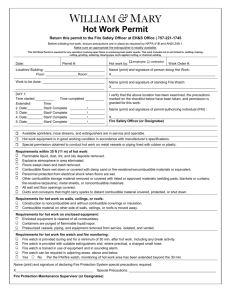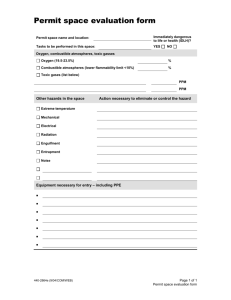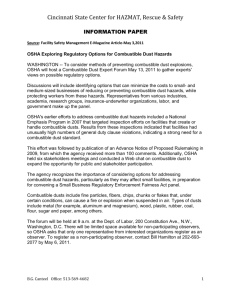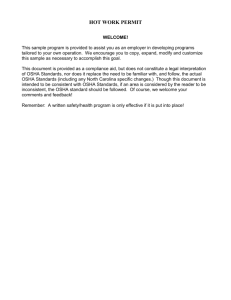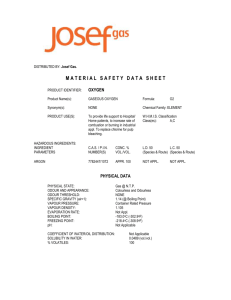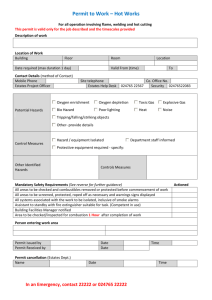Hot Work Permit - University of Limerick
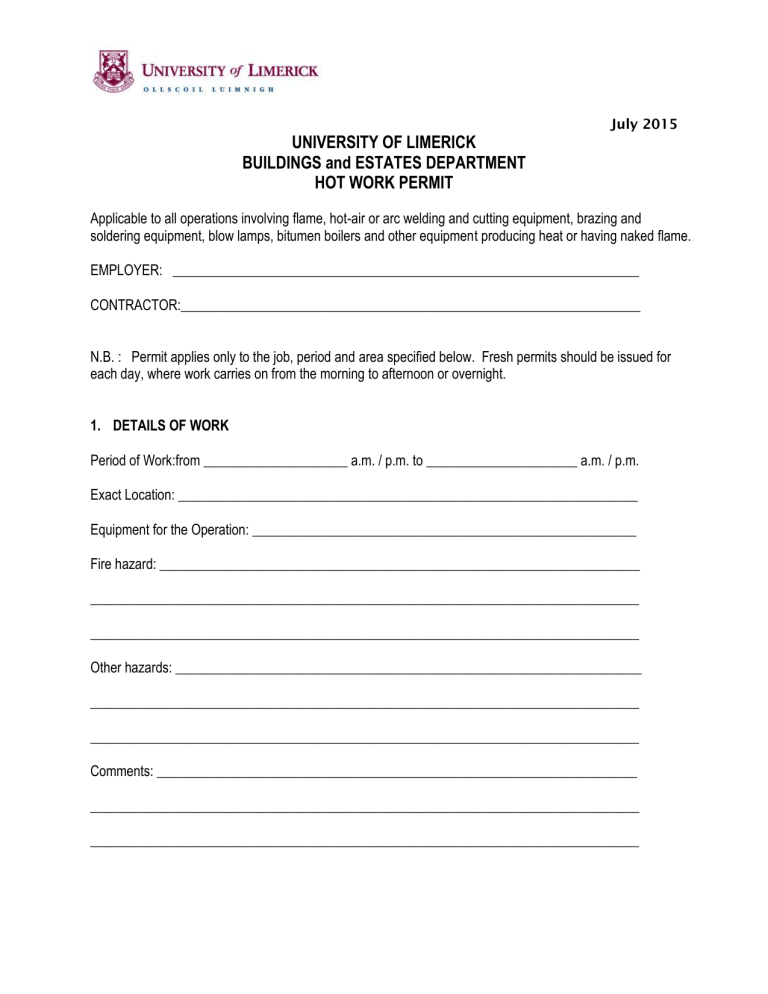
July 2015
UNIVERSITY OF LIMERICK
BUILDINGS and ESTATES DEPARTMENT
HOT WORK PERMIT
Applicable to all operations involving flame, hot-air or arc welding and cutting equipment, brazing and soldering equipment, blow lamps, bitumen boilers and other equipment producing heat or having naked flame.
EMPLOYER: ____________________________________________________________________
CONTRACTOR:___________________________________________________________________
N.B. : Permit applies only to the job, period and area specified below. Fresh permits should be issued for each day, where work carries on from the morning to afternoon or overnight.
1. DETAILS OF WORK
Period of Work:from _____________________ a.m. / p.m. to ______________________ a.m. / p.m.
Exact Location: ___________________________________________________________________
Equipment for the Operation: ________________________________________________________
Fire hazard: ______________________________________________________________________
________________________________________________________________________________
________________________________________________________________________________
Other hazards: ____________________________________________________________________
________________________________________________________________________________
________________________________________________________________________________
Comments: ______________________________________________________________________
________________________________________________________________________________
________________________________________________________________________________
2. FIRE PRECAUTIONS (to be ticked in each case by person carrying out check).
General Conditions:
______ The location specified above has been examined
______ Any sprinklers installed are operative
______ Cutting and welding equipment is in good repair and adequately secured
______ There are no combustible liquids, vapours, dust or gases present
______ The work will be carried out by, and under the supervision of, trained personnel
______ Provision for the attendance of an employee of the contractor during and for one
hour after completion of work. Such employee being supplied with extinguishers or
small bore hose and trained in the use of such equipment and in sounding alarm
______ He and the operatives have had the nearest fire alarm/telephone pointed out to them
and have been told what to do in the event of a fire
______ Warning notices have been displayed
Precautions within 15m of work:
______ Floor swept clear of combustible materials
______ Combustible floors protected by wetting down and covering with damp sand or
sheet of non combustible material
______ Combustible materials and flammable liquids protected with non-combustible
curtains or sheets
______ All wall and floor openings covered with sheets of non-combustible material
______ All gaps in walls and floors through which sparks could pass covered with sheets of
non-combustible material
______ When work is above floor level, non-combustible curtains or sheets suspended
beneath the work to collect the sparks
Work on Walls or Ceilings:
______ Combustible constructions protected by non-combustible curtains or sheets
______ Combustible away from opposite side and clear of any metal likely to conduct heat
______ Where metal beams / pipes are being worked on and, extend through walls or partitions must
be taken on the far side of such wall or partition.
Work on enclosed equipment (tanks, containers, ducts, dust collectors, etc):
______ Equipment cleaned of all combustibles
______ Containers free of flammable vapours
3. AUTHORISATION BY EMPLOYER
I have personally checked the aforementioned precautions and consider it safe to carry out this work
Date: __________________________________________________________________________
Between: _______________________ a.m. / p.m. and___________________________ a.m. / p.m.
Permission is granted to____________________________________________________________
To use: _________________________________________________________________________
In the ___________________________________________________________________________
Company Representative (print name)_________________________________________________
Signature:_______________________________________________________________________
Date:_______________________________Time ________________________________________
4. ACKNOWLEDGEMENT BY CONTRACTOR
I fully understand the hazards of this work and the precautions to be taken. These have also been fully explained to the operatives carrying out this work and I consider them competent to do it safely. I will return my copy of this permit to the Buildings Office (Binder marked ‘Completed Hot Works Permits’) when the work has been safely completed.
Contractor’s Supervisor (print name) _________________________________________________
Signature _______________________________________________________________________
Telephone ______________________________________________________________________
Date _______________________________ Time _______________________________________
5. CANCELLATION
Work areas and all adjacent areas to which sparks and heat might have spread were thoroughly inspected on completion of the operation, and one hour later no smouldering fires were discovered.
Signature
Contractor’s Supervisor (print name) __________________________________________________
Date _______________________________ Time _______________________________________
Company Representative___________________________________________________________
Date _______________________________ Time _______________________________________
GENERAL GUIDELINES
THE HOT WORK AREA
Employers should ensure that the area in the immediate vicinity of the hot work is fully secure.
In particular, you should ensure that:-
Before starting hot work, an area within at least 10m of the hot work process is cleared
Of all loose combustible material and if work is to take place on one side of a wall or partition, the opposite side is examined to ensure no combustible material will be ignited by conducted heat.
Where combustible materials cannot be removed from the area, they are completely protected by non-combustible screens or blankets. Flammable liquids must always removed form the area.
Combustible floors are covered with overlapping sheets of non-combustible material
That the floor is swept clean of combustible materials
That all wall and floor openings, and all gaps in walls and floors through which sparks could pass, are covered with sheets of non-combustible material.
Good ventilation is provided in all areas where hot work is being carried out
Where work is above floor level, that non-combustible material is suspended beneath the work to collect sparks.
WORK ON WALLS OR CEILINGS
Where work is being carried out on walls or ceilings, the employer should ensure that combustible constructions are protected by non-combustible curtains or sheets. Combustibles should also be moved away from the opposite side of the wall or ceiling and cleared of any metal likely to conduct heat. Remember, where metal beams or pipes are being worked on, and they extend through walls or partitions, precautions must be taken on the far side of the walls or partitions.
WORK ON ENCLOSED EQUIPMENT
Where hot work is being carried out on enclosed equipment such as tanks, containers, ducts or dust collectors, the equipment must be cleaned out of all combustibles and containers checked to ensure they are free of flammable vapours.
SETTING UP FIREWATCH
When hot work is being carried out, a trained employee should be in attendance during and for one hour after the completion of the work. This employee should be provided with fire extinguishers or a small bore hose and should be trained to use this equipment and sound the alarm.
Both the fire watch employee and the operatives carrying out the hot work should know where the nearest fire alarm and telephone are located and must know what actions to take in the event of a fire.
They should be aware of:-
Escape Routes – Fire Points – Location of Fire Extinguishers – Alarm Call Points
Telephones from which the Fire Brigade(s) may be summoned
Means of raising alarm
First Aid Facilities
The employer should ensure that warning notices have been displayed throughout the work place
Following Completion of Hot Work:
When hot work is complete, items such as paint stripping, hot stub ends of welding rods and other waster materials must be removed and disposed of safely. All equipment, including gas cylinders, should be removed to a secure area at the end of the working period or when the task is completed, if this is sooner.
Where bitumen / tar boilers are concerned, only the gas cylinders need to be removed. The fire watch should continue for at least one hour after work is completed.
